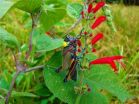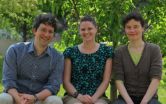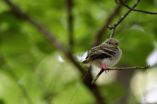(Press-News.org) EUGENE, Ore. -- When tracking a moving object, the two halves of the human brain operate much like runners successfully passing a baton during a relay race, says a University of Oregon researcher.
In a study online ahead of print in Current Biology, electroencephalogram (EEG) measured brainwaves from healthy young adults revealed how information about an attended object -- one being watched closely -- moves from one brain hemisphere to the other.
Such handoffs are necessary because the human visual system is contralateral; objects on the left side of space are processed by the right hemisphere and vice versa. When objects change sides, the two hemispheres must coordinate so that the tracked object isn't lost during the exchange.
"Attentional tracking is something we do on a regular basis when driving in traffic or walking through a crowd," said Edward K. Vogel, professor of psychology. "Our world is dynamic. We're moving. Our eyes are moving. Objects are moving. We need to use our attention to follow objects of interest as they move so that we can predict where they are going."
People experience a smooth and seamless visual world despite information quickly being transferred back and forth between the hemispheres. "A car in your rearview mirror that moves from one lane to the other doesn't suddenly disappear and then reappear on the other side," he said. "The exchange is smooth, in part, because often the hemispheres coordinate a soft handoff."
That means, he said, that before the object crosses into the other side of space, the new hemisphere picks it up, and the old hemisphere continues to hang on to it until it crosses well into the other side of space. Both hemispheres grab hold of the object during the exchange -- much like in a relay race when two runners both briefly have hold of the baton to assure it isn't dropped.
Eventually, Vogel said, such research may help us better understand individual differences in people's visual tracking abilities. Some people, for instance, have trouble picking up a moving vehicle seen in a rearview mirror once it enters a blind spot. "This new technique allows us to watch the brain as information about a target is handed off from one side to the other, and it may provide insights into why attention is so limited," Vogel said.
While psychological studies have often looked at attention and awareness, there has been little focus on how the two hemispheres interact. Interestingly, Vogel said, cellphone companies have long studied a similar problem: how to best transfer a call's signal while a customer moves from one zone of a cell tower to another.
Cellular carriers using Code Division Multiple Access (CDMA) such as Sprint and Verizon utilize a soft handoff between towers, similar to the new findings. Global System for Mobile (GSM) carriers, such as T-Mobile and ATT, use a hard handoff in which a signal leaving a tower's coverage is rapidly shut off and then turned on by the next tower -- a scenario that tended to, before the technology improved, result in more dropped calls.
INFORMATION:
The National Institutes of Health (grants IF32EB011959, RO1MH077105 and R01MH65576), the Office of Naval Research (grants N00014-12-1-0972) and National Geospatial Agency (grant HM0177-13-1-0001_P00001) supported the research.
The paper's lead author was former UO doctoral student Trafton Drew, who has since completed a postdoctoral fellowship at Harvard Medical School and about to join the University of Utah faculty. Additional co-authors with Vogel were UO graduate student Irida Mance and Harvard University faculty members Todd S. Horowitz and Jeremy M. Wolfe.
About the University of Oregon
The University of Oregon is among the 108 institutions chosen from 4,633 U.S. universities for top-tier designation of "Very High Research Activity" in the 2010 Carnegie Classification of Institutions of Higher Education. The UO also is one of two Pacific Northwest members of the Association of American Universities.
Source: Ed Vogel, professor of psychology, 541-3 346-4905, vogel@uoregon.edu
Links:
About Vogel: http://psychweb.uoregon.edu/people/vogel-edward
Vogel's lab: http://psychweb.uoregon.edu/~pk_lab/index.htm
Psychology department: http://psychweb.uoregon.edu/
Follow UO Science on Facebook: http://www.facebook.com/UniversityOfOregonScience
UO Science on Twitter: http://twitter.com/UO_RIGE
More UO Science/Research News: http://uoresearch.uoregon.edu
Note: The University of Oregon is equipped with an on-campus television studio with a point-of-origin Vyvx connection, which provides broadcast-quality video to networks worldwide via fiber optic network. In addition, there is video access to satellite uplink, and audio access to an ISDN codec for broadcast-quality radio interviews.
Oregon researchers capture handoff of tracked object between brain hemispheres
Findings may open a new way to study individual differences in people's visual tracking abilities
2014-05-08
ELSE PRESS RELEASES FROM THIS DATE:
New grasshopper species named after Grammy winner
2014-05-08
A newly discovered grasshopper by University of Central Florida scientists now bears the name of Grammy-award winning singer and activist Ana Lila Downs Sanchez.
The scientists named the new species discovered on the side of a mountain road near Oaxaca, Mexico, after the Mexican-American singer as a nod to her efforts to preserve indigenous culture and penchant for wearing colorful, local costumes as part of her performances.
"It was primarily Paolo's idea to name the grasshopper after the singer" said Derek Woller, one of the authors of the paper referring to colleague ...
Obesity drug failing patients due to lack of education about side-effects
2014-05-08
A new study, published today in the Journal of Health Psychology, found that patients who gained weight 18 months after taking Orlistat attributed their weight-loss failure either to the side effects which have prevented them from sticking to the medication or felt that the medication simply had not worked.
The team from the University of Surrey also found that participants described a series of barriers to weight loss including psychological and physical health issues, relationships and the make-up of their bodies. They also described a number of alternative methods ...
Urine test best detects alcohol use in liver transplant candidates, recipients
2014-05-08
Researchers from Italy confirm that urinary ethyl glucuronide (uEtG) accurately detects alcohol consumption in liver transplant candidates and recipients. The study published in Liver Transplantation, a journal of the American Association for the Study of Liver Diseases and the International Liver Transplantation Society, suggests that a combination of uEtG and the Alcohol Use Disorders Identification Test for alcohol consumption (AUDIT-c) are best in alerting doctors to alcohol consumption by patients undergoing evaluation for liver transplantation or who have received ...
Breakthrough made at Max F. Perutz Laboratories
2014-05-08
Researchers at the Max F. Perutz Laboratories (MFPL) of the University of Vienna and the Medical University of Vienna made a breakthrough for the Platynereis model system, as they describe the first method for generating specific and inheritable mutations in the species. The method, in combination with other tools, now places this marine bristle worm in an excellent position to advance research at the frontiers of neurobiology, chronobiology, evolutionary developmental biology and marine biology. The study and a review on Platynereis dumerilii genetic methods were chosen ...
Fungus may help stop invasive spread of tree-of-heaven
2014-05-08
A naturally occurring fungus might help curb the spread of an invasive tree species that is threatening forests in most of the United States, according to researchers.
Researchers tested the fungus -- Verticillium nonalfalfae -- by injecting it into tree-of-heaven, or Ailanthus, plots, according to Matthew Kasson, who recently received his doctorate in plant pathology and environmental microbiology from Penn State. The treatment completely eradicated the tree-of-heaven plants in those forests.
"It appears that this treatment is effective in Pennsylvania and could ...
New paper provides important insights into carcinoma-associated fibroblasts
2014-05-08
A new paper by a team of researchers led by Zachary T. Schafer, Coleman Assistant Professor of Cancer Biology in the Department of Biological Sciences at the University of Notre Dame, offers important new insights into the role carcinoma-associated fibroblasts (CAFs) play in tumor biology. A number of recent studies have revealed CAFs to be a major contributor to tumor progression through a variety of mechanisms. Despite this information, the precise role CAFs play in augmenting the growth of tumors is still poorly understood.
In their new paper, Schafer and his fellow ...
'Teenage' songbirds experience high mortality due to many causes, MU study finds
2014-05-08
Nearly one-third of songbird species across North America are experiencing long-term declines. Scientists have spent years researching potential causes for these population declines, focusing on the birds when they have just hatched as well as when they are adults. Now, researchers from the University of Missouri and the U.S. Department of Agriculture have found that songbirds are vulnerable to environmental dangers particularly when they are juveniles, shortly after they have left their parents' nests. Frank Thompson, a scientist with the USDA Forest Service and an associate ...
Hepatitis C virus: How viral proteins interact in human cells
2014-05-08
Viruses use human cells in order to multiply and spread. This process involves interactions with cellular host factors as well as virus-virus interactions. For example interactions among viral proteins are essential for the assembly of newly produced infectious virions.
Interaction network explains viral mechanisms and opens up possibilities for new treatments
Hepatitis C virus (HCV) forms a precursor protein, which is processed into ten viral proteins. Scientists at the Institute of Virology at the Helmholtz Zentrum have now discovered how these proteins interact with ...
Promising role for interleukin-10 in scarless wound healing
2014-05-08
New Rochelle, NY, May 8, 2014—The powerful anti-inflammatory compound interleukin-10 (IL-10) plays a crucial role in regenerative, scarless healing of fetal skin. Studies of IL-10 in postnatal skin wounds have demonstrated its promise as an anti-scarring therapeutic agent, as described in a Critical Review article published in Advances in Wound Care, a monthly peer-reviewed journal from Mary Ann Liebert, Inc., publishers and an Official Journal of the Wound Healing Society. The article is available free on the Advances in Wound Care website.
In "Regenerative Wound Healing: ...
Detecting trace amounts of explosives with light
2014-05-08
University of Adelaide research may help in the fight against terrorism with the creation of a sensor that can detect tiny quantities of explosives with the use of light and special glass fibres.
Published in the journal Sensors and Actuators B: Chemical, the researchers describe a novel optical fibre sensor which can detect explosives in concentrations as low as 6.3 ppm (parts per million). It requires an analysis time of only a few minutes.
"Traditionally explosives detection has involved looking for metals that encase them such as in land mines," says project leader ...
LAST 30 PRESS RELEASES:
Commercially viable biomanufacturing: designer yeast turns sugar into lucrative chemical 3-HP
Control valve discovered in gut’s plumbing system
George Mason University leads phase 2 clinical trial for pill to help maintain weight loss after GLP-1s
Hop to it: research from Shedd Aquarium tracks conch movement to set new conservation guidance
Weight loss drugs and bariatric surgery improve the body’s fat ‘balance:’ study
The Age of Fishes began with mass death
TB harnesses part of immune defense system to cause infection
Important new source of oxidation in the atmosphere found
A tug-of-war explains a decades-old question about how bacteria swim
Strengthened immune defense against cancer
Engineering the development of the pancreas
The Journal of Nuclear Medicine ahead-of-print tip sheet: Jan. 9, 2026
Mount Sinai researchers help create largest immune cell atlas of bone marrow in multiple myeloma patients
Why it is so hard to get started on an unpleasant task: Scientists identify a “motivation brake”
Body composition changes after bariatric surgery or treatment with GLP-1 receptor agonists
Targeted regulation of abortion providers laws and pregnancies conceived through fertility treatment
Press registration is now open for the 2026 ACMG Annual Clinical Genetics Meeting
Understanding sex-based differences and the role of bone morphogenetic protein signaling in Alzheimer’s disease
Breakthrough in thin-film electrolytes pushes solid oxide fuel cells forward
Clues from the past reveal the West Antarctic Ice Sheet’s vulnerability to warming
Collaborative study uncovers unknown causes of blindness
Inflammatory immune cells predict survival, relapse in multiple myeloma
New test shows which antibiotics actually work
Most Alzheimer’s cases linked to variants in a single gene
Finding the genome's blind spot
The secret room a giant virus creates inside its host amoeba
World’s vast plant knowledge not being fully exploited to tackle biodiversity and climate challenges, warn researchers
New study explains the link between long-term diabetes and vascular damage
Ocean temperatures reached another record high in 2025
Dynamically reconfigurable topological routing in nonlinear photonic systems
[Press-News.org] Oregon researchers capture handoff of tracked object between brain hemispheresFindings may open a new way to study individual differences in people's visual tracking abilities




